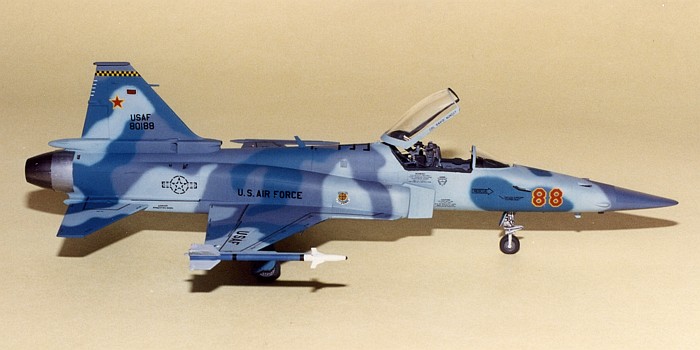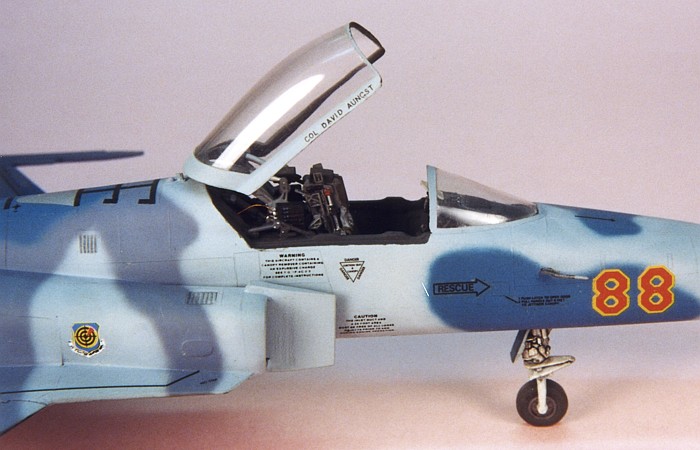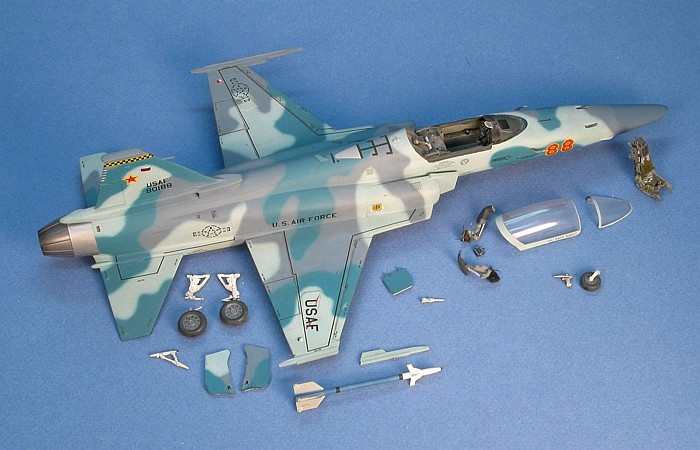| Occasionally I like
to play "what if..." games and this is one example.
I really like the lines of the
F-5/T-38 family and the F-20 is just an extension of those lines
into a newer generation fighter. There was a brief period where
the US Air Force considered the Tigershark for use as an
aggressor aircraft to replace the aging F-5E's that were in use
at the time. In the end, the F-5E's soldiered on and were
eventually replaced by the F-16. This model is my guess at what
a production F-20A would have looked like, camouflaged in the
markings of the 57th Fighter
Weapons Wing.
With its F-5 looks and F-16 performance, would the F-20 have
really been Eagle Fodder?
The Monogram F-20 kit is not a bad model, but it
leaves room for some improvements. The kit is easy to build and
has raised scribing. The cockpit is well molded with a nicely
detailed main instrument panel and multipart ejection seat. The
landing gear, speed brakes, and cockpit canopy can all be built
either open or closed. Unlike the older F-5E kits from
Monogram to which this kit shows definite lineage, the
canopy actuating mechanism is better molded and even looks
somewhat like the real thing.

When I built this model, I was in the stage of modeling where
no kit could be built simply out-of-the-box. I just had to
change something. I made the following changes and updates to
the model.
- I added minor cockpit detailing using fine brass wire.
- I "production-ized" the airframe.
- I added various antennas using thin sheet styrene.
- I scribed the spillway for an aerial refueling point
on the aircraft spine.
- I added the aerial refueling flood light (like on
the F-16) in the leading edge of the vertical tail.
- I added reinforcing bulges to the upper wings that
match the same details seen on the Hasegawa 1/72nd
scale F-20 kit.
- I drilled out the ECS intake on the front of the
vertical tail base and opened the ECS exhaust ports on
either side.
- I added a Hasegawa weapons set AIM-9J Sidewinder
to the wing tip. I wanted to add an ACMI pod to the other
wing missile rail, but at the time I built the kit there
were none available (and I did not feel like
scratch-building one).
 The
model is painted mostly in Testor's Model Master enamel
paints. The
model is painted mostly in Testor's Model Master enamel
paints.
The camouflage is my personal favorite of the various early
aggressor schemes, known as "Blue Glop". The colors are Dark
Blue (F.S.35109), Intermediate Blue (F.S.35164), and Medium Blue
(F.S.35414). The Dark Blue is a Humbrol color. The rest
are Model Master. Since the time when I built this model, Model
Master now includes the Dark Blue color in their paint line.
The decals come from SuperScale decal sheet #48-053,
F-5E Tiger II Aggressors. The markings represent how aircraft
were marked in the 64th and 65th
Tactical Fighter Training Squadrons (TFTS) of the 57th
Fighter Weapons Wing (FWW) based at Nellis AFB, Nevada, circa
1988. I decided to use low-visibility national insignia, but
retained the rest of the markings as seen on the F-5E's. The
aircraft data markings come from various sources including a
SuperScale sheet on the F-15.
As is common for me with my models, I added my own name as
the pilot. This was done one ... letter ... at ... a ... time
using N-scale railroad lettering decals. It is amazing how easy
it is now to just print up a pilot's name on my computer and
apply it as a single decal. Time and technology certainly do
march on...

For weathering, I used my typical style of thinned down
enamel paint washes and air brush shading. I finished the
weathering with some dry brushing to pop out the surface
details. For a more complete discussion of what I do to weather
my models, see my posting on
"Weathering Aircraft".
The pictures seen in this posting are from a few years back.
This model was a part of the "great avalanch of 2002" where I
slipped on the steps and tossed five models to the base of the
steps. Three of the five faired OK, are already fixed, and are
again sitting on my display shelves. However, the F-20 was not
one of those "lucky ones".
The F-20 currently looks like this...

... waiting for me
to repair it.
Because of some deep scuffs in the paint and major damage to
the landing gear, I am leaning on just stripping the kit as part
of a more extensive rebuild and creating a different paint
scheme. A fellow HyperScaler graciously sent me his spare F-20
landing gear to assist in the rebuild. Time will tell what I end
up doing, either just fixing the damage or completely rebuilding
the kit.
|
Home
| What's New |
Features |
Gallery |
Reviews |
Reference |
Forum |
Search